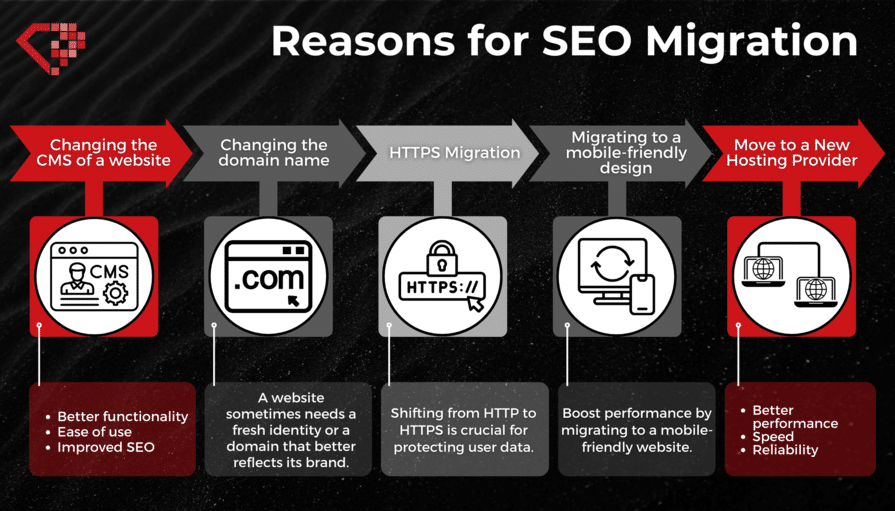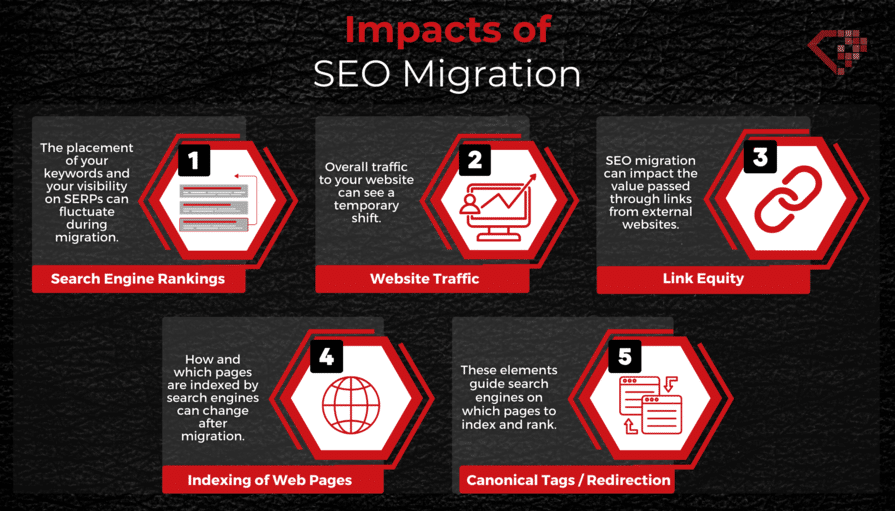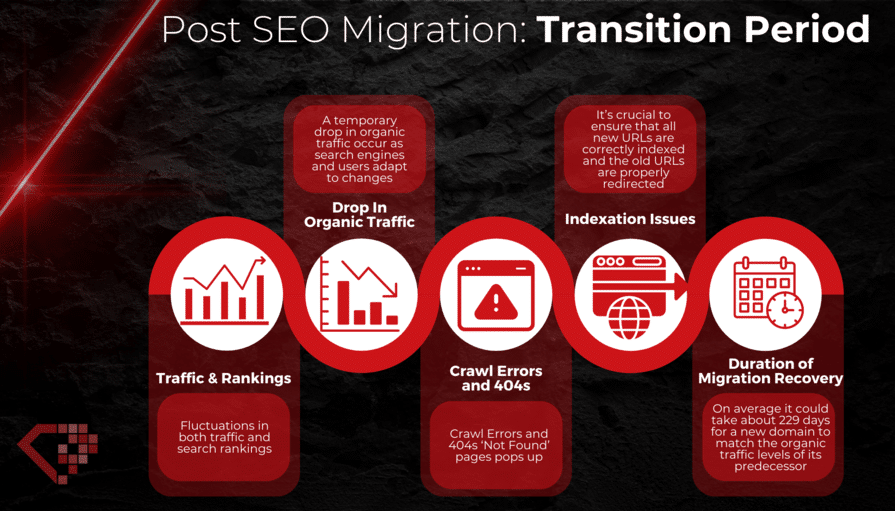In today’s digital landscape, maintaining or improving your website’s visibility is crucial for any modern business. Sometimes, a full SEO migration becomes necessary to align your website to fluctuating consumer preferences or needs.
What is SEO Migration?
The undertaking of moving all of the content and SEO benefits from your present website to a new or updated version is known as SEO migration. This could entail making structural changes to your website, transitioning to a new domain, changing to HTTPS, or making your site mobile-responsive.
Why go Through an SEO Migration?
Making sure your website stays competitive and relevant is the key objective of an SEO migration. A properly managed SEO transfer creates the groundwork for a more durable website going forward, regardless of the goals you have for it—rebranding, improving consumer experience, or bolstering site security.
It’s critical to understand that SEO migration may cause brief disruptions such as variations in search rankings, brief variations in website traffic, and other issues. We at Ruby Digital are aware of the difficulties involved in an SEO migration and how they could affect your online presence.
We’ll look at the impacts and causes of SEO migrations in the sections that follow. You’ll get greater knowledge about these migrations, their possible effects, and how to deal with the changes in an efficient manner.
Cause and Effect: Understanding the What and Why of SEO Migrations
SEO migration is more than a technical process; it’s a strategic decision aimed at keeping your website competitive in the digital landscape. Let’s delve into a few of the objectives behind SEO migration and how they can influence your presence online.
Possible Causes of Migrations in SEO
Adapting a Website’s CMS
Most of the time, the process starts with the need to move your website’s Content Management System (CMS), maybe from an antiquated platform to something more modern like WordPress. The requirement for improved SEO skills, user-friendliness, and functionality is what motivated this update.
Domain Name Changes
Every now and then a website needs a facelift or a domain name that better represents its brand. This might mean changing the Top-Level Domain (TLD), adding or eliminating “www,” or going through a total rebranding. Although SEO and domain movement are closely related, careful preparation can lessen the impact of SEO and preserve the authority of your website.
HTTPS Migration
The shift from HTTP to HTTPS is essential for safeguarding consumer data and offers SEO advantages, as a search engine prioritizes secure websites.
Changing to a Design That Is More Mobile-Friendly
Given the prevalence of browsing on a mobile device, having a mobile-responsive website is imperative. Transitioning to a design that adapts seamlessly to screens that are smaller can significantly enhance your site’s user engagement and SEO performance.
Changing to a Different Hosting Company
Shifting your site to a new hosting company in order to increase dependability, speed, or performance is known as migration. Even while users might not notice these changes, they can have a big impact on the loading speed and general SEO health of your website.
The long-term goal of each scenario is to elevate user experience and website performance. But it’s important to recognize that moving a website could affect SEO. A well-thought-out SEO migration plan maximizes the advantages of these adjustments in the long-run while minimizing their negative consequences.

The Effects of Moving Your Website’s SEO
Due to SEO migration, several aspects of your website’s online appearance may change. Comprehending these effects is essential to a seamless transition and for preserving the functionality of your website after migration.
Search Engine Rankings
One of the most obvious effects of SEO migration on your website is an increase in search engine ranks. During the changeover, Search Engine Results Pages (SERPs) may exhibit fluctuations in keyword placement and visibility. To reduce any negative effects on your site’s rankings, careful planning and execution of the migration are essential.
Website Traffic
There can be a brief change in the amount of visitors to your site overall as search engines review and re-index your site following a move. Even though these are frequently temporary setbacks, it’s crucial to keep a careful eye on traffic patterns to quickly resolve any persistent problems.
Link Equity
SEO migration may have an impact on link equity, or the value transferred through links to other websites. Redirects must be implemented correctly to maintain this link power, which has a big impact on SEO results.
Indexing of Web Pages
Search engines’ indexing procedures and standards for websites may alter after migration. It’s critical to keep an eye on your site’s indexation to make sure search engines are recognizing and ranking all of the important pages.
Canonical Tags and Redirections
During migration, it is essential to manage canonical tags and redirections effectively. These components help avoid duplicate content problems and guarantee that the right pages maintain their SEO worth by directing search engines on which pages to index and rank.
It’s important to consider a couple of other areas that may be impacted:
User Experience (UX)
The user experience may be impacted by migration even though it isn’t directly related to SEO, especially if the site’s structure or design changes. By indirectly impacting your site’s SEO through measures like engagement rate and average time per session, a great user experience (UX) is essential for maintaining visitors’ interest.
Local SEO
In order to reflect any changes made during migration, such as a new domain or business name, it is imperative that websites with a strong local presence update their local SEO components, such as Google Business Profiles (formerly Google My Business listings) and local citations.
With meticulous preparation, implementation, and post-migration monitoring, the effect of migration can be controlled and minimized in each of these areas. You can help ensure that your website maintains its SEO potency following the migration by closely monitoring these factors.
Post Migration – the Transition Period:
After completing the SEO migration, your website transitions into a critical phase. Understanding what occurs during this period is crucial for ensuring an efficient return to normalcy.
Temporary Fluctuations in Traffic and Rankings
At first, traffic and search rankings are likely to fluctuate. As a search engine re-crawls and re-indexes your new site, this is normal. During this time, it’s crucial to be patient and keep a close eye on everything.
Initial Drop in Organic Traffic
Following a migration, it’s typical to see a brief drop in organic traffic while users and search engines adjust to the new environment. During this period, keep a tight check on analytics to spot any persistent tendencies that might need attention.
Crawl Errors and 404s
Crawl problems and 404 ‘Not Found’ pages may appear after the migration. Take quick action to fix these problems so that users have a good experience and search engines can scan your website more easily.
Indexation Issues
There could be problems with how websites are indexed. To preserve SEO integrity, it is essential to make sure that outdated URLs are appropriately redirected and that all new URLs are appropriately indexed.
Duration of SEO Migration Recovery
An analysis of Search Engine Journal’s data sheds light on the average recovery period following relocation. The study’s objective was to determine a typical recovery period for SEO migrations by examining 171 domain migrations.

Key findings from the study include:
- Some new domains were able to attain the organic traffic levels of their predecessor in less than a month, but it took an average of 229 days for them to accomplish so.
- The intricacy and unpredictability of SEO migrations are shown by the noteworthy 42% of migrations that did not result in a return to the initial levels of organic traffic.
- The study emphasizes that every website is different and that the recovery timeline is greatly influenced by elements like backlink profiles and migration management.
Planning and establishing reasonable expectations depend on your ability to comprehend this information.
Understand that the recovery process can occur gradually, perhaps taking several months. It is a reminder that although SEO migrations usually pay off in the long run, getting back to where you were previously performing in search engine optimization takes time and careful planning.

In conclusion, navigating SEO migration involves more than just changing your digital address—it’s a strategic maneuver that is important for keeping your website aligned with the ever-evolving digital realm. Here are some key points to remember:
- SEO migration serves strategic purposes: Whether it’s to enhance functionality, bolster security, or undergo rebranding, SEO migration is often a necessary step for website development.
- Temporary fluctuations are normal: Expect fluctuations in traffic and rankings during the transition phase. However, these early effects are typically short-lived.
- Careful planning is essential: Thorough planning and execution help minimize negative impacts, facilitating an efficient transition and faster recovery.
- Recovery takes time: Recovery timelines can differ, sometimes extending over several months. Endurance and ongoing optimization are crucial during this period.
- Post-migration monitoring is vital: After the migration, regular monitoring and tweaks are required to find and fix any problems and gradually enhance the functionality of your website.
The long-term advantages of SEO migration outweigh the difficulties. A well-conducted migration offers a basis for improved performance and expansion in addition to maintaining the SEO value of your website.
We at Ruby Digital are experts in negotiating the subtleties and difficulties of SEO migrations. Our experience guarantees smooth transfers that have the least possible negative effects on search engine rankings and website traffic. Please get in touch with us if you need professional advice or if you’re thinking about migrating your SEO. Working together, we can make sure that your website grows stronger online rather than just maintaining it.
Find out more about the creation and design of our websites, as well as SEO services.




